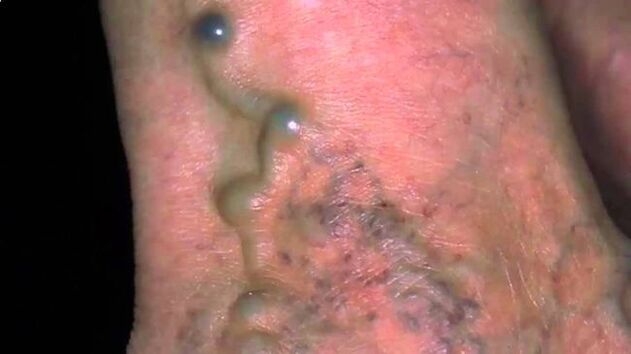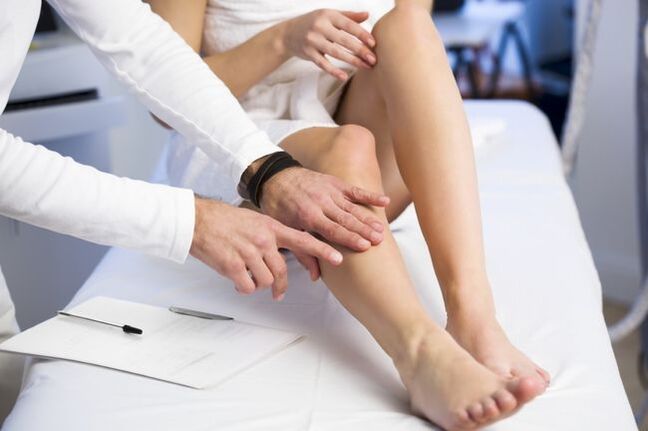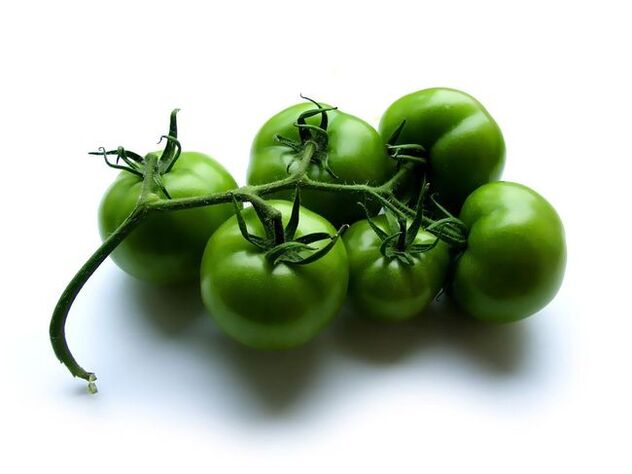Varicose veins in the legs or varicose veins (from the Latin varicis - "swelling") is a disease of the blood vessels of the lower extremities, in which the flow of blood is disturbed due to the malfunction of the venous valves: the veins they expand, lengthen, begin to protrude under the skin, nodules form. Varicose veins cause great discomfort due to edema, pain, and the dangerous formation of blood clots and trophic ulcers. This disease in severe cases, unfortunately, can lead to disability.
This disease is extremely common: more than 60% of the world's population suffers from it). It has haunted mankind, apparently from the moment of its appearance: varicose veins are mentioned in the Old Testament, archaeologists found during excavations in Egypt a mummy with a trophic ulcer on the leg with traces of treatment, signs can be seen of varicose veins on the legs of ancient statues and, according to written evidence, ancient physicians Avicenna and Hippocrates were looking for methods to treat varicose veins. Scientists suggest that this is humanity's price for walking upright, as this disease is much less common in other species.
Although women suffer from varicose veins more often than men, due to having children and hormonal problems during menopause, varicose veins in the legs in men often progress faster and have much more serious consequences. This is due to the fact that so-called "male" jobs are often associated with regular heavy lifting, and traditional stereotypes urge men to ignore minor pain.

Causes of the disease
Since varicose veins in the legs are caused by excessive blood pressure in the vessels, the following factors, along with congenital connective tissue weakness, can cause it:
- stand for a long time, work standing up. Varicose veins of the legs are considered an occupational disease of waiters, because they have to walk with heavy trays, hairdressers and surgeons who have to do their work standing for many hours at a time;
- a long time sitting in a chair and long stays with bent legs, in which the vessels are pinched and blood circulation is impaired;
- over weight,
- pregnancy - a woman's weight increases quite quickly, and at the same time the pressure on the legs increases, hormonal changes during pregnancy also affect the walls of the veins;
- wearing tight socks, elastic band socks and similar factors;
- hypodynamics;
- overloading the body during sports, during work associated with frequent weight lifting;
- malfunction of the endocrine system, as well as various hormonal disorders, which are a common cause of varicose veins on the legs in women;
- leg injuries, foot deformities.
Varicose veins of the legs.
Varicose veins occur:
- Congenital.The probability of inheriting this disease from parents is over 70%. Congenital varicose veins can manifest at any age, but, as a rule, it manifests itself at a young age, and in rare cases, it even occurs in babies. This form of the disease has additional unpleasant symptoms: a noticeable increase in one leg, sometimes hemangiomas (vascular tumors) appear throughout the body. Hereditary varicose veins can also appear in the veins of internal organs;
- Primary varicose veins. This type of ailment develops as a consequence of the reasons listed above;
- Secondary varicose veinsit usually begins as a complication of venous thrombosis or as a result of trauma.
The disease is generally divided into the following stages:
- 0- asymptomatic, when disorders begin to occur at the cellular level, but do not yet manifest themselves in the form of formed symptoms;
- 1- the appearance of noticeable symptoms, which, however, still have little effect on the ability to work;
- 2- at this stage, severe edema becomes permanent, nodules and trophic ulcers appear. A sick person cannot do without a special support team during the day;
- 3- serious complications, disability.

As you can see, varicose veins on the legs is quite a serious disease, the treatment of which should be started when the first signs appear to avoid dire consequences.
Symptoms
Despite the variability of the symptoms in each case, it will not be difficult to recognize varicose veins of the legs. Its main manifestation, for which the disease got its name, is the expansion of the veins in the legs. There may be "cobwebs" or "asterisks" in the subcutaneous vessels; by the way, they will be more noticeable on women's legs. This is due to the fact that men have more "greenery" on their legs, so the thin threads of the blood vessels can go unnoticed.
The disease progresses slowly over many years or even decades. In the early stages of the disease, the symptoms are few and generally nonspecific: there is a feeling of heaviness, swelling, pain in the legs, sometimes burning, and night cramps. Swelling of the feet and ankles, vein pain are especially common symptoms with varicose veins in the legs. At first, the edema appears infrequently, is mild and disappears after resting in a horizontal position, but if therapeutic and prophylactic measures are not taken, the venous insufficiency becomes chronic and the edema appears regularly for no particular reason. These manifestations tend to intensify at night, after a working day, and also in hot climates.
What is the danger of varicose veins?
Often the first signs of varicose veins of the legs are ignored, the disease is gaining momentum and irreversible processes begin, leading to extremely unpleasant consequences - trophic ulcers and thrombophlebitis.
Trophic ulcers are a painful, non-healing wound on the foot or lower leg due to poor blood supply to the tissues. This quite painful disease manifests itself more often in later life and its treatment can last for the rest of your life.
Thrombophlebitis is an inflammation of the vein wall, in which blood clots form a blood clot that blocks the lumen of the vein.
Signs of thrombophlebitis, which developed against the background of varicose veins, are as follows:
- fever, chills;
- lumps along the veins, quite painful
- swelling of the limbs
Thrombophlebitis can continue chronically with periodic exacerbations, possibly the so-called purulent fusion of the formed thrombus (septic thrombophlebitis); then the infection spreads rapidly throughout the body along with the blood.
Important!A torn blood clot or part of it can enter the pulmonary artery, leading to a pulmonary embolism and often death. Do not let the disease run its course and do not neglect the supervision of a specialist!
Diagnosis and treatment
The diagnosis and treatment of varicose veins is carried out by a phlebologist, who should be consulted if there are symptoms of this disease. Modern diagnostic methods (ultrasound angiography, Doppler ultrasound, etc. ) will determine how much the veins are affected and prescribe the correct treatment.

In the treatment of varicose veins, drug treatment and compression therapy are used in combination, as well as surgical methods that are considered the most effective.
There are many drugs that increase the tone of the venous walls, reduce their permeability, improve microcirculation and lymphatic drainage. They can be ointments, gels, tablets with various active ingredients, of natural or synthetic origin.
Gels, ointments and creams are used in home therapy, applied to the affected areas of the vascular network. These drugs are divided into groups:
- Heparin ointments. Heparin has a resorbing effect, prevents stagnation of blood.
- Ointments and gels made on the basis of natural ingredients relieve fatigue, pain, strengthen blood vessels, are recommended during pregnancy.
- In the treatment of thrombophlebitis, drugs based on non-steroidal anti-inflammatory drugs are used.
- Hormonal drug-based ointments and gels also have anti-inflammatory effects.
Along with local drugs, to achieve the best effect, venotonics, phlebotonics, anticoagulants are prescribed, and if necessary, anti-inflammatory drugs are prescribed orally or in the form of injections.
Compression therapy has been used for varicose veins in the legs since ancient times: Roman legionaries would tighten their calves with strips of skin to prevent swelling and pain during long military transitions, and Egyptian pharaohs were sometimes depicted in bandages. elastic in the hands. This simple method works by reducing the diameter of the superficial veins, which causes an acceleration of blood flow and a decrease in the amount of "ballast" blood in the legs.
Today, they wear not only an elastic bandage, but also more comfortable compression stockings. The bandage is applied from the toes to the middle of the thigh. Both the bandage and compression stockings are worn in the morning in a horizontal position and worn all day, and removed at night.
Treatment with folk remedies can be used in combination with these medications. Folk remedies and to some extent effective are horse chestnut infusion, garlic and lemon infusion, green tomato compresses.

Green tomato compresses are good for treating varicose veins on the legs.
However, when dealing with home remedies, you need to be careful and approach this process with healthy criticism. If you go to any forum dedicated to this topic, then, in addition to really good, tried and tested recipes, you can find many incredible ideas, from horse manure compresses to ingesting a decoction of poisonous plants, which can be equally useless and harmless, and can lead to serious harm to the body, since not only a specialist, but also an ordinary "Internet troll" or just a person with a sick psyche can write in the forum.
Important!Having discovered a new recipe on the Internet, before using the proposed remedy, be sure to consult with your doctor.
It should be noted that conservative treatment, such as treatment with folk remedies, cannot cure varicose veins, but only slows down their development and relieves symptoms.
Surgery
As a minimally invasive and highly effective surgical method, laser treatment or endovasal laser coagulation is used; This method does not require incisions and hospitalization is not necessary for inpatient treatment. Under the influence of a laser beam, a diseased vessel "sticks" and the charge is transferred to healthy vessels. Laser coagulation can be done in the early stages of the disease. Produced under local anesthesia.
Also, in addition to laser therapy, coagulation (gluing) of diseased vessels is carried out using radio frequency waves (radiofrequency coagulation) and by injecting a special substance (sclerotherapy).
Phlebectomy is usually a simple surgery that removes the dilated veins.
With varicose veins, a salt-free diet is prescribed and a proper diet is also necessary if the causes of varicose veins are overweight or diseases of the endocrine system.
Sports with varicose veins are undesirable, therapeutic and prophylactic physical education, cycling, swimming are recommended. There are special exercises for varicose veins.

It is contraindicated to visit a bath, a sauna, a long stay in hot water.
Massage is not used for varicose veins.
Prophylaxis
The prevention of varicose veins in the legs is extremely important for all people, as it is extremely difficult to cure varicose veins completely, fighting against them takes a lot of time and effort, and the cost of treatment is quite high.
First of all, you should try, if possible, to prevent or eliminate the reasons that affect its development:
- avoid standing or sitting for a long time, if this is not possible, do leg warm-up exercises as often as possible;
- refusing to wear tight clothing, leggings, or tight pants;
- choose shoes carefully;
- do not allow excess weight;
- for pregnant women, it is important not to allow overwork of the legs, to rest in a horizontal position during the day;
Recommended:
- an active lifestyle, moderate physical activity, cardiovascular exercise, "inverted" exercises (for example, "birch" is a simple but very effective means of preventing varicose veins);
- hardening, contrast shower;
- good nutrition;
- Rest in a horizontal position during the day.

Tip!A good form of prevention is to raise your legs slightly above head level while resting horizontally, placing a pillow or roller underneath them and staying in this position for 3-5 minutes, but no longer.






































